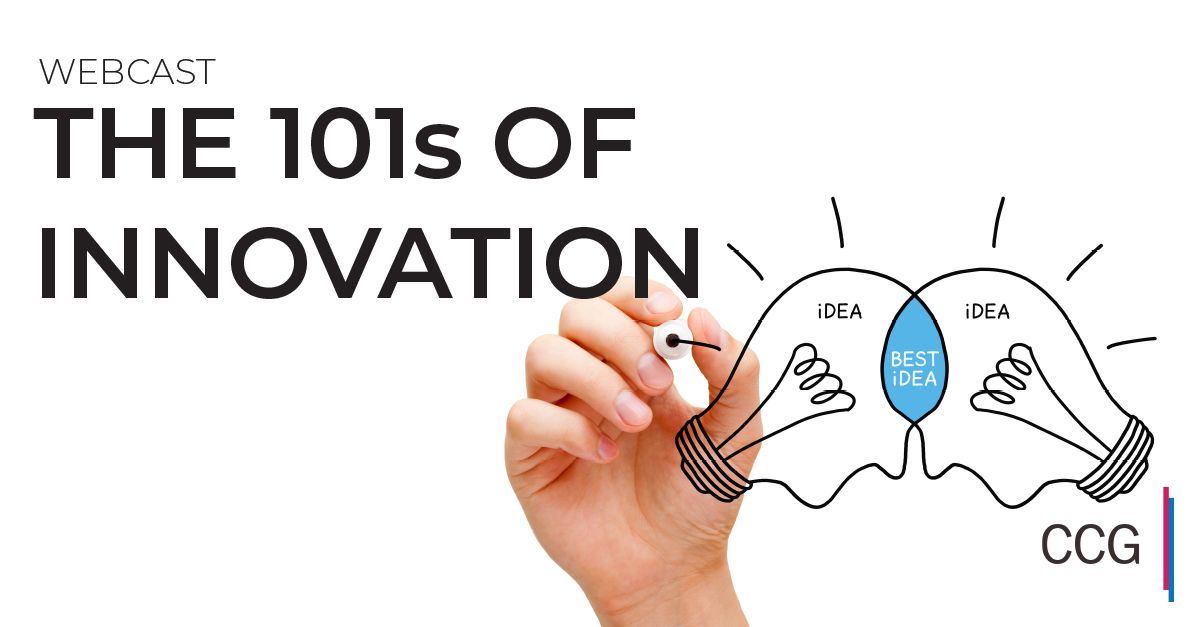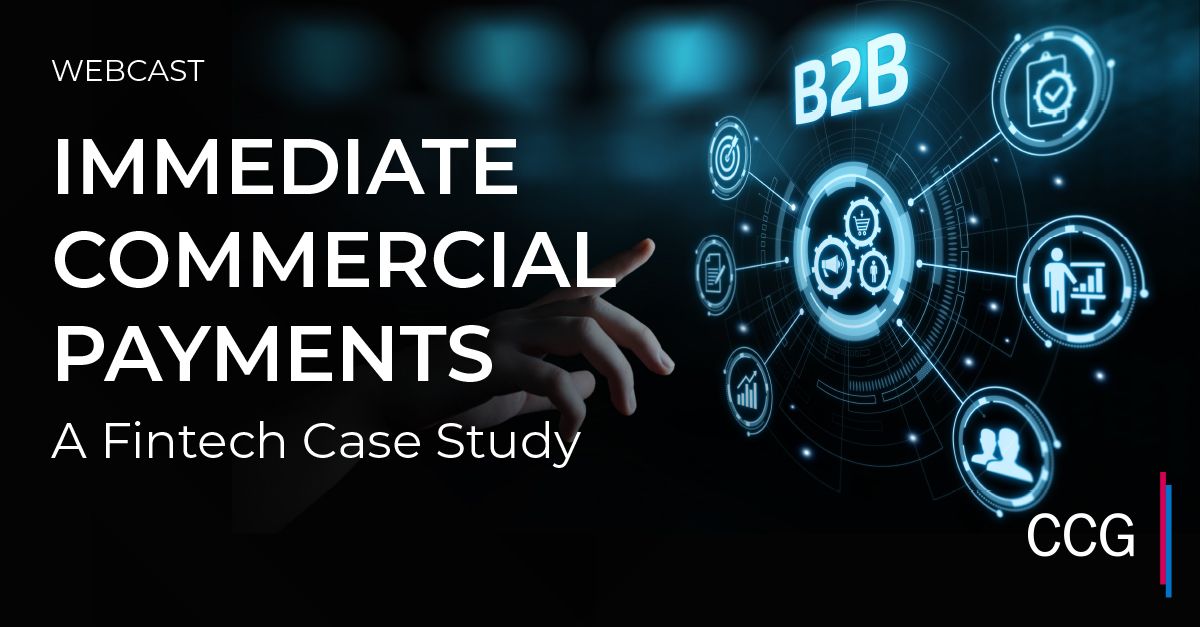The 101s of Innovation
Available On Demand – 19 minutes
Innovation has been a part of financial services for years but recently efforts have started ramping up across large and small financial institutions alike. What does this mean for you and your organization? Join the CCG team with host Emily Lockwood as she sits down with CCG’s Managing Director and Chief Strategy and Innovation Officer Scarlett Sieber to discuss the basic principles of innovation and basic steps you can do today to incorporate innovation into your strategy.
Subscribe to CCG Insights.
[restrict]
Emily Lockwood Hi, welcome to the CCG Webcast. I’m Emily Lockwood, your host and Marketing Communications Consultant at CCG Catlayst. I’m joined today by Scarlett Sieber. She is the Managing Director and Chief Strategy and Innovation Officer at CCG. Hey, Scarlett, thanks for joining us today.
Scarlett Sieber Hey, Emily. Thanks for having me. Looking forward to this chat on a topic that is very close to my heart as a super excited about this conversation.
Emily Lockwood Great, We’re excited to hear it. You have to say. So before we get into all of that, I want to do a few housekeeping items. If you look at the bottom of where Scarlett and I are live, you will see our faces. You can go ahead and give us a click. That’ll pull up our bios. You can get in contact with us via e-mail, Twitter and LinkedIn. You’ll also see the CCG logo. If you click into that, you’ll see a bunch of resources from CCG and go to our Web site. See some of our published articles and our blog. And then there’s also a Q and A button. This is super important. We want you guys to interact with us, ask us questions. That’s why we do these. And then you can also get in contact with us via Twitter through the blue icon. So today, we’re going to talk about innovation. We hear about this topic, a lot. The word is used a lot, but what does it really mean? Which leads me right to my first question is what is innovation for financial institutions?
Scarlett Sieber Yeah, Emily, I think that’s a nice question to kind of set the stage here. Innovation, I think for financial services, let’s say innovation in general. Introduction of something new, a new idea method or a device which is such a broad and simplistic way of defining it. But honestly, it’s really the best way to do that because I have had the pleasure of working at a variety of financial institutions during my career and certainly have financial many times institutions as clients. And each one, I can say, has a different definition of what innovation is. So it’s really kind of special and applicable to that organization. But at the high level, for the purpose of the conversation that you and I are having, as we’re kind of getting to the fundamentals of innovation, it’s really about from a bank or credit union lens. How are we challenging ourselves to think about and do things differently than what we’ve done before?
Emily Lockwood Got it. OK. So knowing all of that, why should smaller financial institutions consider innovation now in light of everything else that is going on?
Scarlett Sieber Yeah, I was very curious to see, you know, with what’s happened this year with the pandemic and other things, the impact on innovation, because historically the role of the CIO in this case, chief innovation officer, which CIO can also be information officer as well. But what I’m referring to CIO for this conversation, we’re going to be talking about innovation. That role within financial services has been a pretty prominent role for at least the last five years, if not a little bit longer. But what you tend to see, and this is not only what’s in financial services, but definitely true in our industry, is that when things come up, when there is a bit of a downturn, when there are cuts to budgets to be made, innovation function typically is one of those first things that gets cut. So I was very curious to see with what’s happening this year what the impact would be. And I was pleasantly surprised actually. I started spending time talking to my peers and clients and others that the innovation hiring practice post COVID has actually enhanced and picked up. And I think there’s a few reasons for that. The world is changing so quickly. We’ve been pushed and forced into a digital first world. Our clients are being pushed into a digital first world, the ones who were still the traditional ones who love that experience at their branch with their teller every day, are oftentimes now having to figure out how to do things that they never did before online. And so really, digital and innovation have moved from a nice to have the people we’ve talked about a little bit to must have. So I think we know why should a smaller financial attention consider innovation now. If you want to be around five years from now and beyond, you have to start thinking differently today and the impact of this virtual new life that we live in as kind of helps to accelerate that to a degree that it hasn’t before. So back to the fact that innovation is actually increasing in terms of hiring practices. I think there are a lot of executives because of things like PPP and everything else, have been focused on the immediate needs, which makes sense given this new reality that we’ve lived in and getting through this pandemic. The strategic executives are also putting the pieces in place to really accelerate their initiatives and innovation and digital is top of that list.
Emily Lockwood Got it. OK. So knowing all of that, you know, you mentioned how to stay relevant and be prepared for what’s to come in five years. So if the leadership team is going to sit down and build their innovation strategy, what are some good questions that they can ask to get the ball rolling?
Scarlett Sieber Gosh, so many questions. I think with anything that you do in situations like this, especially an undertaking like innovation, it goes back down to the fundamentals of “why”. So I think the first question is, why are we doing this? What is what is the motivating factor behind this? And there is a lot of answers to that. It’s because we’re in the middle of and dealing with this pandemic. And so we’re being responsive to that. We don’t want to be left behind because everyone else is starting to think about that. Part of it is just staying up to date and aware of the latest trends and things that are happening with fintech and more broadly. A lot of times, too, while they wouldn’t ever initially say this from deeper conversations that I’ve had. What you end up discovering sometimes is that they want to get into innovation because they believe that it would enhance their brand to be known as an innovative company. And none of those answers are wrong. By the way. But once you and your executive or management team can kind of clearly defined the why and the motivation factors behind it, it makes everything else that comes afterwards a lot more consistent and worthwhile. And like everyone is on the same page. So I’d say that’s one question. Understanding expectations for what you want to get out of innovation is certainly important. So what are the expectations at a high level and kind of setting the stage for that? And some of it is just curiosity. We just want to get our, you know, our foot in the pool, which is also OK, but just identifying what that is. And then I would say the third thing and really we could have and we probably should have many more episodes on the different types of innovations because there is a lot. But is this something when we say we want to move forward, the innovation initiative, is this something that we want to do and implement company-wide? Is this going to be a very specific area that we’re not really going to talk about? Or is it something that we want to, you know, fundamentally bake into our culture moving forward?
Emily Lockwood So once the executive team or the leadership team figures out there why, what is the best way to structure an innovation initiative when you’re just getting started?
Scarlett Sieber Yeah, there’s a few things I would say the most important is just getting started is the key phrase that you said in that question. Starting small. Starting small is the best thing to do. It’s nice. And like I said, if one of the things is as in response to the industry and you see your peers having a 10 million dollar or five million dollar or 20 million dollar innovation budget to be reactive and say, well, we need to have the same. And I’m not saying that you shouldn’t do that eventually. You probably should. But to really start small you have small everything. So a small budget. Small measurements of success. From a headcount perspective, I would say when you’re just getting started, even having one or two people is a great start. The most important thing when I say that, though, is that they are dedicated to this function. A lot of times I’ve seen that when the executive team is thinking about innovation, what they’ll do is they’ll try to kind of piggyback it on top of other titles for people. So they will be the chief “X” and innovation officer or they’ll be ahead of whatever and innovation so that they have their full time job, which is what they’ve been accustomed to for a period of time. And that innovation is just an additional thing that they’re responsible for. I personally think that that is limiting to the capabilities and opportunities with innovation. So having at least one or two people fully dedicated, what is their full time job to think about, implement and act innovation is super, super important. And really, when you’re just getting started, there’s like focusing on ideas. It’s a lot about idea generation. Getting people to get comfortable with being uncomfortable and thinking outside of the box, I think are a few of the key things I would say if you were just getting started.
Emily Lockwood That’s good to know. So what about what happens after you get started? You have your innovation strategy, you know? What does success look like?
Scarlett Sieber That is a favorite question that I get asked. Not favorite for me, I’m certainly happy to answer it, but I can’t. Almost every executive in banking and elsewhere, by the way, wants to the answer to this question, which makes sense. The short answer is there are many, many ways to measure success. I think going back to the conversation that we had a few minutes ago around, when you’re thinking about your innovation strategy, what does that look like? If you can clearly define what success looks like from the on set of everything that makes everything else easier. So you want to have a clear idea of what it is you want to measure. So a very simplistic example would be, OK, so I’ll just give you an example. I saw a graphic on LinkedIn from the online application process for consumers, for banks, and they had a bunch of different examples from banks and fintechs. And so let’s say hypothetically that yours was it took 18 steps to get from point A to point Z, and you want to do that same process. And I’m just throwing out a fake number here. But nine steps instead of 18 or 12 steps instead of 18. It doesn’t have the necessary the number, but it’s like maybe it’s the timing. Usually it takes five minutes to complete the application. We want to be able to get the relevant, pertinent information still done in a legally compliant way with the right people involved in three minutes. Things like that. So you can get very, very specific examples there. But I would say honestly, when you’re first doing it and every institution has a different strategy here. I was at a conference with PNC back in January and they have no measure. I shouldn’t say so but there are the C Suite executives that have talked about the way that they measure. And they said they’re very intentional about not specifically defining success in that way because they think that that actually limits the productivity and outcomes. So everyone has a different idea. I’d say, you know, growth, R&D. One really nice metric, especially if it’s something that you’re doing more broadly across your organization, is the impact on culture. So how has this impacted your retention rate, your hiring rate, your employee satisfaction? Do people feel that they’re actively empowered and participating in the company’s mission? There are some cool things there which you wouldn’t necessarily probably traditionally associate with innovation that can come out of that, of course, net promoter score. So are these things that you’re doing? Are they working it? Are your clients responding in a positive way? And, you know, like I said, really at the at the end of it, it’s did you achieve what you hoped to on the onset when you set your expectations or at minimum, could you use this as an R&D opportunity? And did you avoid a costly mistake, like say, hey, we want to go into were primarily consumer bank and want to go into business banking without going and throwing everything and except for the kitchen sink at it, let’s do some small test for innovation in a tournament. Oh, that was a really bad idea. We actually end up saving a lot of money.
Emily Lockwood OK. That’s really, really helpful. So thinking about innovation and coming up with the strategy and understanding what questions you need to ask before you develop that strategy. I really want our audience to sort of leave with a tangible takeaway. So Scarlett, can you give us a tactical or practical example of how a smaller financial institution could implement those principles today?
Scarlett Sieber Yeah, there are a few things that I think you could start doing immediately without having when we talked about kind of getting start with innovation, without having the dedicated resources, because that’s not something that you could, I mean, you could probably start today, but it would take a little bit more time, energy effort to think about all that. So if you just wanted to start getting accustomed to it, open to the ideas of utilizing these innovation principles, I think two ideas that probably come to mind. One being something that you would do company wide, where you would have, you know, kind of like an internal call for ideas, which you could say is something like, hey, like let’s say you’re one a very specific problem that you want to solve. We’re noticing from our data that our client, aren’t saving. We want to find a way to encourage our clients to save more. Companywide, how would you go about solving that and whomever so that everyone can submit applications or whatever else, and then you can have some type of a prize for whoever wins. And there could be a lot of different ways that you could identify what that prize is. Time with the CEO, recognition, this, that or the other, you know, time on that you something on the website. But there are something like that which gets the attention from the company wide perspective. The other thing, which is a little bit more specific, but in a similar vein, is really around almost like a limited incubator of sorts where and I’ve done this before at smaller financial institutions where you take the key areas within the organization, lending, risk payments, whatever. Every area that is relevant that you think should have a stake in the future of what you’re doing and you bring key people from each department into a room together. I tried to focus on people who had been there for a long time and the people who were just brand new, people who were experts in the space, people who were newer to the space and put them all in a room and really asking them to come to the meeting. And we still had a high level topic. Right. So let’s use that example with savings, but maybe a different, you know, something else. And I’d ask them to come with two ideas. One that was like the practical, immediate response. And the other that was more game changing. And in fact, the question was a little bit more broad, where they were able to say, you know, if there’s one thing you can do to improve your area, let’s say it’s lending. What would that look like? Kind of like your immediate thing. And then what’s some big idea that you have. Not surprisingly, the doers of the organization, the ones who were in there on the day to day and in the weeds. Their answers were very practical and specific. Well, we can take this process and move it to here, which was good. And that’s definitely part of the process. But they tended to have a little bit harder time with the big picture of how do we change or doing mentally. Either way, one of the things that was super interesting about getting these people in the room together was even though they’re in the same company, some of them were on the same floor, a few desks away from each other. They didn’t have a full understanding of what it is that each other did. And so because of this exercise, they started to understand each other more, which helped a lot culturally and with a few other issues that had arisen before that. So really, it’s about leveraging the intelligence of your organizations. You could just start tomorrow. I would take advantage of those big, brilliant minds that you have at your company now and ask them to think differently and get involved and get excited about what you guys are doing.
Emily Lockwood OK. Thank you, Scarlett. That’s really helpful. I know that was a lot of information. So it’s really helpful to sort of have a tactical example of how to implement everything that was discussed today. If you guys have more questions, feel free to reach out to us. We’re here as a resource for you. We’d like to keep these webcasts about 15 minutes long. We know you guys have really busy days. I really appreciate that you took some time to spend with us today. Again, if you ask of questions and we didn’t have time or we didn’t get to you, don’t worry, we’ll be reaching out to you by the end of the day. And we look forward to seeing you on our next webcast. Thanks.
Scarlett Sieber Yeah. Thank you, Emily. And the one thing that I would just add is, as you can tell, I and the team spent a lot of time thinking about this. I’ve experienced this in many different organizations directly myself and through our clients. So if you have questions and maybe are not sure where to start with some of this stuff, just send us a note. We’re happy to have an introductory conversation just to help think through these things, because it can be overwhelming and intimidating. And we really want to be here as that trusted partner and resource for you. So that’s all.
Emily Lockwood All right. Thank you.
Scarlett Sieber Thanks, Emily.
[/restrict]
Business Continuity: Unlocking Digital Commercial Banking Capabilities
Financial Brand Article: Over the COVID Horizon, Mobile Banking Demands Strategic Clarity
Digital Dreams – Expanding Commercial Banking Capabilities
Financial Brand Article: Is It Finally Time for Open Banking’s Debut in America?
Emily Lockwood is the Marketing Communications Consultant for CCG Catalyst. Her experience in communication and public relations enables her to implement creative strategies for clients that create public and media awareness. She is skilled in strategic planning, social media, event planning and pitching. Her professional experience includes writing for the Arizona Republic, managing social media for the NFL, and creating campaigns for FOX Broadcasting and NBC Universal. She also has extensive agency experience and has worked for a range of clients including hospitality, real estate and healthcare.
Chief Strategy & Innovation Officer Scarlett Sieber is one of the world’s premier voices in financial services. She is among the industry’s most sought-after speakers as a thought leader and innovator with expertise in driving organizational change at both startups and enterprises across the financial services and fintech ecosystem. Scarlett has been invited to speak at over 100 prestigious financial services and technology conferences globally, including Money20/20, Finovate, South Summit, and NASA’s Cross Industry Innovation Summit.
Scarlett’s experience includes founding her own startup as well as working at banks such as BBVA, USAA, and Opus Bank. She is a leading fintech influencer, included on lists such as Top 100 Women in Fintech 2019 and Top 10 Fintech Influencers in the U.S. Scarlett also has deep experience in digital strategy and innovation implementation, making her a key asset to building cutting-edge programs for our clients.









